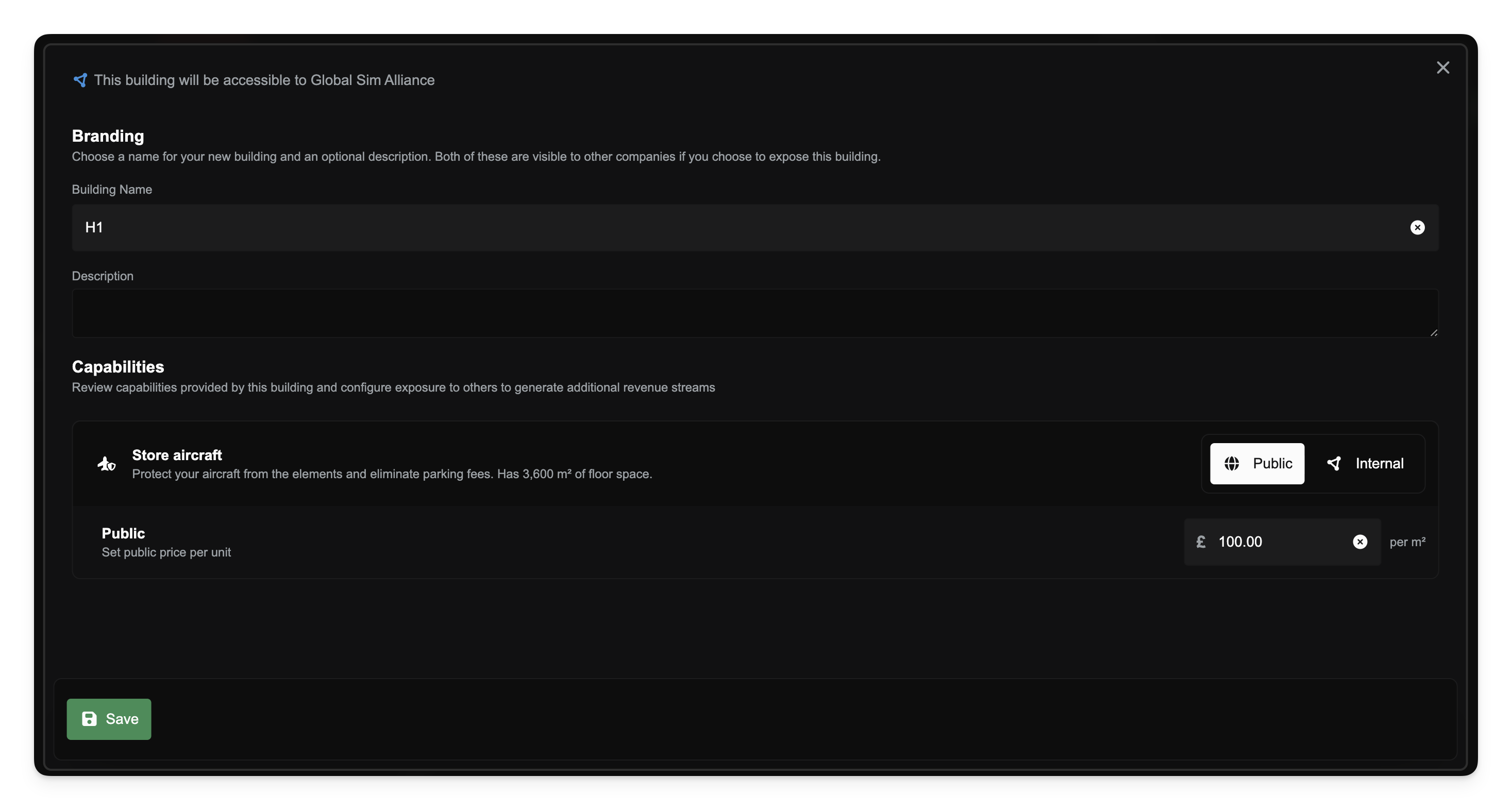Hangars
Hangars offer secure on-site storage for your aircraft at an airport and prevent parking fees.
Each hangar building has a limited capacity that you can check by viewing the building in the Operations Cockpit.

The footprint (in m²) that an aircraft takes up is calculated based on it's length and wingspan. More information about how to find this data is shown in Aircraft Database and Information
Building Size
In order to build buildings of a certain size you must satisfy the pre-requisite infrastructure requirements. Please check Operations Centres for more information.
Micro Hangars have 144m² of floor space
Small Hangars have 225m² of floor space
Medium Hangars have 900m² of floor space
Large Hangars have 3600m² of floor space
Huge Hangars have 10,000m² of floor space
Automatically Hangaring Aircraft
FSCharter automatically attempts to place General Aviation (GA) aircraft into hangars when appropriate. See Parking for more information.
Manually Hangaring Aircraft
To manually move an an aircraft into a hangar navigate to the Operations Cockpit and select the Base Operations lens. Select the airport where you have a hangar and then click on the hangar from the dock. The Hangar dialog will then open up.

The dialog displays the Hangar name, its location (airport ICAO), and the owning company.
Beneath this, you’ll see the Capability Overview and, on the right-hand side, the Settings and Sharing button.
To update the Hangar name or description, click Settings and Sharing. A new dialog will open where you can edit and save your changes.
To move an aircraft into the Hangar, click the green Use button. This opens a new dialog with two columns:
Available: Aircraft on the tarmac at this airport that are eligible for hangar storage. These are your company’s aircraft currently on the ground and not involved in another operation (no active flights or maintenance jobs).
In Hangar: Aircraft currently stored inside this Hangar.

Each aircraft row displays its tail number, type (ICAO code), and passenger capacity (shown as seat icons). On the right-hand side of each row, you’ll see action buttons:
+(Move to Hangar): Adds the aircraft to the Hangar.–(Remove from Hangar): Removes the aircraft from the Hangar.
Hovering over these buttons shows the tooltips “Move to Hangar” or “Remove from Hangar”. Only aircraft that are on the ground at this airport (and not mid-flight or undergoing maintenance) will appear in the Available list.
Storing and removing aircraft
Store an aircraft: Find it under Available and click Move to Hangar.
Remove an aircraft: Find it under In Hangar and click Remove from Hangar.
These actions immediately update both lists, moving the aircraft between columns, and refresh the occupancy meter. If the Hangar is already full (100% occupied), you cannot add more aircraft until space is freed.
Hangar capacity
Each Hangar has a fixed capacity. The interface always shows how much floor space is in use and how many remain available, giving you a clear view of whether you can store more aircraft or need to make room first.
Partnerships and Hangar Access
All companies in your partnership can use your Hangars free of charge. This makes partnerships especially valuable for groups that want to share infrastructure and reduce costs.
Shared access: Any partner company can move aircraft into or out of your Hangars without paying storage fees.
Automatic availability: Partnership Hangars are always treated as “internal use,” so no extra configuration is required.
Strategic benefit: By pooling Hangar space across multiple airports, partnerships can build a stronger combined network and reduce the risk of running out of storage at busy hubs.
Offering your Hangars to the Public
Other companies that are not in your partnership can use your Hangars to store aircraft, but only if you explicitly allow it. You may also charge a fee for providing this service.
To enable this feature, open the Hangar dialog and click Settings and Sharing. From here, you can toggle whether the Hangar is available for internal use (your company and any partners) or public use.
To protect players, aircraft will not be automatically checked into a paid Hangar. This ensures no one is surprised with unexpected storage fees.

Related Video
Use timestamps in video description to access the related part.